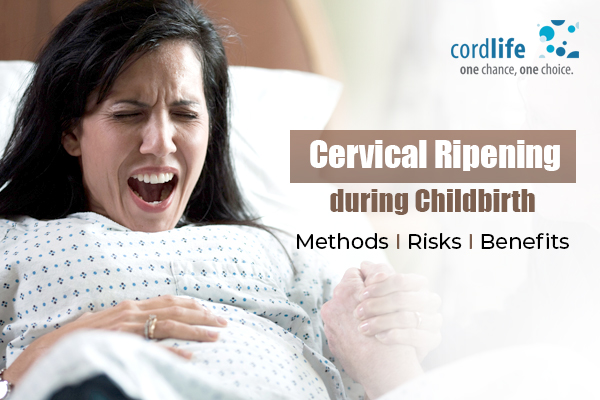Table of Contents
The closer you’re to your due date, we know that you can’t but wait to hold your baby in your arms. You’ve also started worrying about the signs of labour. The signs of contraction, cervix effacement and cervix dilation during your pregnancy and at the time of childbirth are some of the things that you might be feeling a little jittery about.
Cervix dilation is essential at the time of childbirth. However, did you know that cervix effacement or cervix ripening is an equally important process, before you go into labour?
Read this insightful article to help yourself with some more information on the cervix ripening process and the risks and benefits associated with it.
What Is Cervical Ripening?
The cervix is the lowest part of the uterus. It is a cylinder-shaped tissue and is primarily composed of fibromuscular tissue, connecting the vagina and the uterus. (If your cervix is dilated with regular and painful cervical cramping during your pregnancy, you’re in active labour and getting closer to delivering your baby).
The cervix is expected to hold your baby during your pregnancy, but when you are on labour, the normal process of softening and opening of the cervix is called cervical ripening. Although this can happen on its own, but the ripening can also take place with the help of medication or special devices. Studies have claimed that, approximately 83% to 85% women with an indication of labour induction would need cervical ripening.
What Is The Cervical Length Chart During Pregnancy and Labour?
Although the longitudinal chart of cervical length during pregnancy differs from one pregnancy to another, you might have to undergo a transvaginal ultrasound to evaluate the uterine cervical length during your pregnancy journey. During pregnancy, your cervix is 3.5 to 4 centimetres long. As your baby gets ready for labour, the cervix gradually thins out. Once your cervix is 100 percent effaced and dilated, you’re ready to start pushing your baby out into the world.
According to the sonographies, with the progression of your pregnancy, the pregnant cervix naturally and rapidly shortens. Moreover, if you deliver prematurely and have a history of preterm delivery, you might experience a faster shortening. Less than 3cm of the cervix length is considered normal, as the cervix starts softening or ripening by the end of your pregnancy.
However, having a short cervix before 37 weeks of your pregnancy, increases the chances of pregnancy loss, preterm labour, and early delivery.
How Does the Doctor Know Whether You Need Cervical Ripening?
Most of you might request your healthcare provider to take you through this process. Your healthcare provider might determine the need of the process by using a scale called the Bishop score. (In 1964, Edward Bishop set forth this criteria for elective induction of labour, which is widely known as the Bishop score). In fact, this score includes cervical dilation, length, consistency and position in relation to the uterus. This score also tells the status of the cervix. A Bishop score of 8 or greater is considered favourable for induction.
Who Needs Cervical Ripening?
Labour induction means initiation of uterine contraction and ripening for the purpose of delivering the baby. However, your labour might have to be induced or devices might have to be necessary used for cervical ripening when:
- You have prolonged pregnancy
- you might experience health conditions like preeclampsia, and gestational diabetes. Due to which the foetus is also at risk.
- Intrauterine foetal death
Additionally, doctors take you through such medically-indicated deliveries mostly on your request.
How To Soften The Cervix For Labour?
Based on the Bishop score and on your request, these are the methods mostly applied:
Application Of Prostaglandin Medications To The Cervix
Prostaglandins are naturally occurring hormone-like substances that stimulate certain changes in the cervix that cause it to ripen.
Gradual Dilation Of The Cervix
In this method mechanical dilators are used. They absorb the fluid from the tissues helping the cervix to ripen.
Catheter Dilation Of The Cervix
Foley Catheter is used during this process. This is a long and narrow instrument which has a balloon tip. Your doctor guides the Foley catheter through the vagina and into the cervical canal, thus encouraging the cervix to open.
Stripping the Membranes
This method can help start your labour, even when the cervix is only partially dilated. In fact, while carrying out this procedure, your doctor will put the gloved fingers inside the cervix and separate the amniotic sac from the uterine wall.
Artificial Membrane Rupture For Cervical Ripening
This process has been used for many years, thus allowing the amniotic sac to release. Doctors routinely carry out this procedure for cervical ripening.
Pitocin or Oxytocin Insertion
When labour is delayed, your doctor can administer oxytocin to encourage your uterus to start contracting regularly.
There are not just medically induced cervical ripening procedures, natural cervical opening methods are also available to make your childbirth easy. Acupuncture, breast stimulation, use of castor oil, Enemas (injection of water or liquid into the rectum to clear the colon), herbal supplements, hot baths and sexual intercourse are some of the natural ways of cervical ripening.
With frequent contraction, hyperstimulation of the uterus, and uterine rupture the earlier the cervix is thinned out the faster the dilation process takes place. However, you can reduce the chances of cervical ripening medically by proper antenatal check-ups, healthy diet, activities and adequate rest in your pregnancy regime.
Visit the blog page of Cordlife India to understand more on pregnancy, postpartum, childbirth, and cord blood banking.
